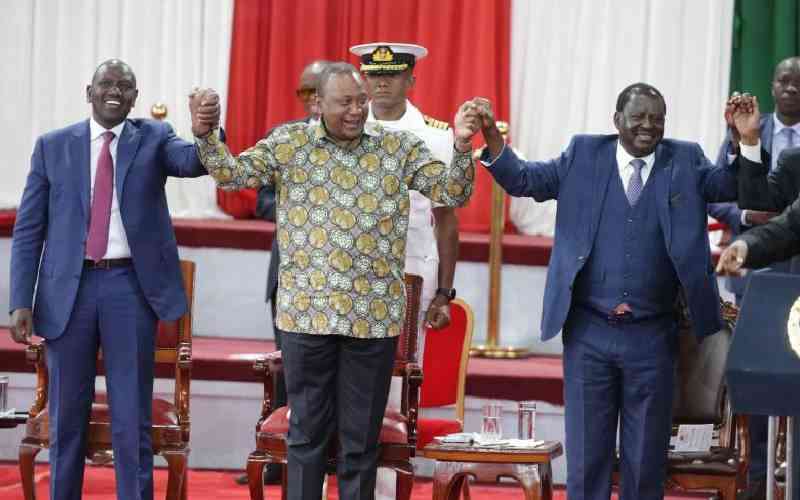
In 2017, the number of bank branches reduced for the first time in over a decade, signaling a change in the market and specifically where lenders were making money.
Banks had realised that instead of going out to bank the ordinary customer, they only needed to hire one person as a Treasury officer, seated in the office, to buy government bonds and bills.
Kenya had only 512 bank branches in 2003 but this network would expand by 28 per cent in 2007 as the lenders sought growth in the country and the region.
In seven years, the number of banks doubled. In 2014, Kenya saw 101 new branches, then in 2015 the number rose by 80 while in 2016 the increase was a mere 18 to a total 1,541 branches. In 2017, there were 23 additional branches.
However, the growth that was then focused on local and regional expansion is now driven by mergers and takeover of failing peers.
A report by the Kenya Bankers Association shows that banks’ strategy to survive has shifted from lending to the economy to lending to the government.
The State of Banking Industry Report, based on 15 years of research, draws a contrasting picture of President Uhuru Kenyatta and President Mwai Kibaki’s handling of the economy.
The report says while the share of banks’ total income from interest on loans and advances remains the largest, its declining growth trend as observed has been compensated by earnings from investments in government securities.
Consequently, crowding out of private sector credit is evident during President Kenyatta’s tenure.
“We have seen the net interest income come down over time, right now it’s about 5.9 per cent. It is not a rosy picture if you look at it from a broader perspective of contributing to the growth of the private sector,” said Kenya Bankers Association (KBA) Research and Policy Director Jared Osoro.
During President Kibaki’s tenure, according to the KBA report, banks were making 20 per cent of their money from the government around 2003.
Reversed trend
But Kibaki turned them away and by 2011 banks only made 11 per cent of their money from the State.
The trend has however reversed with government borrowing contributing about 23 per cent by the end of 2018.
Stay informed. Subscribe to our newsletter
Although Uhuru’s government had promised to go into the international market to debut a Eurobond to allow local businesses borrow at a low rate, his regime doubled up and borrowed heavily locally as well.
The report shows that between 2003 and 2013, the government borrowed Sh1 trillion locally but in just five years after that, Treasury borrowed almost twice the amount to Sh1.6 trillion.
But the same government has not been adequately channeling the money back into the economy, including defaulting on payments to suppliers.
A report by analysts Genghis Capital puts government pending bills at a whopping Sh400 billion, accumulated by counties and the central government over the years.
The bills contribute to an increase in non-performing loans especially among small and medium enterprises (SMEs).
“The outstanding loans and advances are on an increasing path, although the pace has been tapering over the past three years,” KBA Chief Executive Habil Olaka says in the report.
Market distortions that have led to financial resource allocation shifting away from the core of the small and medium enterprises, which are core to the economy’s sustained growth, need to be tackled.
Data from the Central Bank of Kenya indicates commercial banks’ non-performing loans portfolio (NPLs) increased 54 per cent between 2016 and 2017 and now stand at Sh234 billion.
Consistently over the past five years, Kenyan businesses have been unable to repay their loans with the rate of NPLs climbing to a 12-year high.
KBA tracked the bad loans back to 2003, when Kibaki was fresh in office and bad loans were at 35 per cent of total lending.
In the 10 years of his tenure, he managed to bring down the rate of bad loans to less than five per cent, only for them to shoot back up to double digits to 12 per cent in 2018.
The research said the build-up of NPLs over the five years ending 2018 has been noticeable for its persistent rise.
“The industry’s performance in 2018 shows a delicate balance between careful asset growth amidst returns-risks trade-offs and cost management and efficiency enhancement,’’ said Mr Osoro.
The government has recognised its role in the bad loan problem and has started instituting measures to pay suppliers on time especially after Uhuru ordered that pending bill be cleared.
In his Budget speech, Treasury Cabinet Secretary Henry Rotich said the government would start releasing payments owed to both contractors and suppliers as well VAT refunds.
The KBA report however said that in the last two years, bad loans as a proportion of total loans have looked bigger because of the slower lending growth.
“There is an obvious focus on the level of NPLs in the market. Whilst that level is not necessarily in its historical high levels, its persistence over the past five years is feeding into the banking industry’s risk-taking behaviour,” says the report.
The study also debunked the idea that there is a significant shift by banks away from traditional sources of income.
Fees and commissions, whose share of total income has always been substantially lower than both investment in securities and interest from loans and advances, has been on a general downward but erratic trajectory, growing by two per cent in 2018.
Income form the segment declined from about 25 per cent 15 years ago to 14 per cent by the end of 2018.
Interest income
The banking industry’s total income grew by 3.3 per cent in 2018, a reversal of the previous year’s 4.8 per cent decline.
The increase in income during this period was largely attributed to an increase in interest from government securities by 15.68 per cent with the biggest contribution in the increase being among Tier 1 banks.
While that is a positive development, the rate is well below the double-digit levels seen during the 2014–16 period before the rate cap was introduced, limiting the amount of money that could be made by bidding highly on a desperate National Treasury.
Without the rate cap, as was seen in 2015, the government was paying over 20 per cent for bank money. It is currently paying as low as six per cent because banks would rather give government money than what they feel is a risky private sector.
However, banks now foresee a rise in income from Treasury if the rate cap is repealed. Analysts estimate that rates would go up by at least two percentage points now that Finance Cabinet Secretary Henry Rotich has moved to Parliament to repeal the rate cap through the Finance Bill 2019.
This would allow banks to lend to private sector and review rates lent to government.
“I would expect the National Treasury to play hardball for a few months, meaning rejecting bids and dumping options, but the reality is that the yield curve is compressed,” said Jibran Qureishi, Regional Economist East Africa at Stanbic Bank.
“If you look at the long end of the bond we have compressed by north of 200 basis points, there is no reason that we have to believe there will be no increase even if it is moderate on the yield curve.”
Mr Qureishi however said the National Treasury could always go for more Eurobonds because the international market will be awash with cheap cash if the United States cut its lending rates.
“The deficit is scary but the funding of the deficit matters more. The Fed is moving on a dovish pivot, we are probably going to see the first rate cut this month and then another one at the end of the year and two by fall 2020,” he said.
“That means there is going to be a lot of generosity on the external markets to fund our fiscal side.”
 The Standard Group Plc is a
multi-media organization with investments in media platforms spanning newspaper
print operations, television, radio broadcasting, digital and online services. The
Standard Group is recognized as a leading multi-media house in Kenya with a key
influence in matters of national and international interest.
The Standard Group Plc is a
multi-media organization with investments in media platforms spanning newspaper
print operations, television, radio broadcasting, digital and online services. The
Standard Group is recognized as a leading multi-media house in Kenya with a key
influence in matters of national and international interest.
 The Standard Group Plc is a
multi-media organization with investments in media platforms spanning newspaper
print operations, television, radio broadcasting, digital and online services. The
Standard Group is recognized as a leading multi-media house in Kenya with a key
influence in matters of national and international interest.
The Standard Group Plc is a
multi-media organization with investments in media platforms spanning newspaper
print operations, television, radio broadcasting, digital and online services. The
Standard Group is recognized as a leading multi-media house in Kenya with a key
influence in matters of national and international interest.









